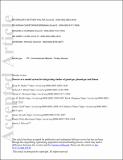Files in this item
Senecio as a model system for integrating studies of genotype, phenotype and fitness
Item metadata
| dc.contributor.author | Walter, Greg M. | |
| dc.contributor.author | Abbott, Richard J. | |
| dc.contributor.author | Brennan, Adrian C. | |
| dc.contributor.author | Bridle, Jon R. | |
| dc.contributor.author | Chapman, Mark | |
| dc.contributor.author | Clark, James | |
| dc.contributor.author | Filatov, Dmitry | |
| dc.contributor.author | Nevado, Bruno | |
| dc.contributor.author | Ortiz-Barrientos, Daniel | |
| dc.contributor.author | Hiscock, Simon J. | |
| dc.date.accessioned | 2021-03-17T00:38:33Z | |
| dc.date.available | 2021-03-17T00:38:33Z | |
| dc.date.issued | 2020-03-17 | |
| dc.identifier | 266317658 | |
| dc.identifier | f26eb262-c90b-47d8-b604-360b46e26fb5 | |
| dc.identifier | 85081999030 | |
| dc.identifier | 000519790300007 | |
| dc.identifier.citation | Walter , G M , Abbott , R J , Brennan , A C , Bridle , J R , Chapman , M , Clark , J , Filatov , D , Nevado , B , Ortiz-Barrientos , D & Hiscock , S J 2020 , ' Senecio as a model system for integrating studies of genotype, phenotype and fitness ' , New Phytologist , vol. 226 , no. 2 , pp. 326-344 . https://doi.org/10.1111/nph.16434 | en |
| dc.identifier.issn | 0028-646X | |
| dc.identifier.other | RIS: urn:84AF99972E878EF89357455C9B887609 | |
| dc.identifier.uri | https://hdl.handle.net/10023/21637 | |
| dc.description | We also acknowledge the national funding bodies that have supported this work, including NERC, The Genetics Society, BBSRC and the Leverhulme Trust in the UK, NSF in the USA, and ARC in Australia. | en |
| dc.description.abstract | Two major developments have made it possible to use examples of ecological radiations as model systems to understand evolution and ecology. First, the integration of quantitative genetics with ecological experiments allows detailed connections to be made between genotype, phenotype and fitness in the field. Second, dramatic advances in molecular genetics have created new possibilities for integrating field and laboratory experiments with detailed genetic sequencing. Combining these approaches allows evolutionary biologists to better study the interplay between genotype, phenotype and fitness to explore a wide range of evolutionary processes. Here, we present the genus Senecio (Asteraceae) as an excellent system to integrate these developments, and to address fundamental questions in ecology and evolution. Senecio is one of the largest and most phenotypically diverse genera of flowering plants, containing species ranging from woody perennials to herbaceous annuals. These Senecio species exhibit many growth habits, life histories and morphologies, and occupy a multitude of environments. Common within the genus are species that have hybridised naturally, undergone polyploidisation, and colonised diverse environments, often through rapid phenotypic divergence and adaptive radiation. These diverse experimental attributes make Senecio an attractive model system in which to address a broad range of questions in evolution and ecology. | |
| dc.format.extent | 29600338 | |
| dc.language.iso | eng | |
| dc.relation.ispartof | New Phytologist | en |
| dc.subject | Adaptive radiation | en |
| dc.subject | Asteraceae | en |
| dc.subject | hybrid speciation | en |
| dc.subject | Quantitative genetics | en |
| dc.subject | Genomics | en |
| dc.subject | Model system | en |
| dc.subject | Senecio | en |
| dc.subject | Self-incompatibility | en |
| dc.subject | QH301 Biology | en |
| dc.subject | T-NDAS | en |
| dc.subject.lcc | QH301 | en |
| dc.title | Senecio as a model system for integrating studies of genotype, phenotype and fitness | en |
| dc.type | Journal article | en |
| dc.contributor.institution | University of St Andrews. School of Biology | en |
| dc.identifier.doi | https://doi.org/10.1111/nph.16434 | |
| dc.description.status | Peer reviewed | en |
| dc.date.embargoedUntil | 2021-03-17 |
This item appears in the following Collection(s)
Items in the St Andrews Research Repository are protected by copyright, with all rights reserved, unless otherwise indicated.

